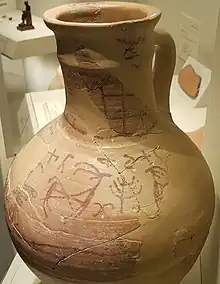
._LOC_matpc.03321.jpg.webp)


The Lachish ewer is an artifact discovered at Tell el-Duweir, identified as the site of the ancient city of Lachish, one of the most important cities in the Kingdom of Judah. The jar shows an example of how the tree and pubic triangle can be synonymous or interchangeable.[2] The common goats flanking a tree motif is known from very early examples, like old Babylonian Akkadian, on. During this era they symbolize the goddess Asherah.[3]
The jug is considered as important as pithos A from Kuntillet Ajrud and the Ta'anakh cult stand.[4] It is one of the most common points of reference to demonstrate the development of the Semitic or early Hebrew script as well as Judean art and Canaanite religion.
Comparative
An excellent parallel called the Burna krater was publicized in 2022; see Shai.[5]
See also
Bibliography
- Hestrin, Ruth (1987). "The Lachish Ewer and the 'Asherah". Israel Exploration Journal. Israel Exploration Society. 37 (4): 212–223. ISSN 0021-2059. JSTOR 27926074. Retrieved 2023-12-28.
- Locatell, Christian; McKinny, Chris; Shai, Itzhaq (2022-09-30). "Tree of Life Motif, Late Bronze Canaanite Cult, and a Recently Discovered Krater from Tel Burna". Journal of the American Oriental Society. 142 (3). doi:10.7817/jaos.142.3.2022.ar024. ISSN 2169-2289.
- Winter, Urs (1983). Frau und Göttin (in German). Freiburg, Schweiz Göttingen: Vandenhoeck & Ruprecht. ISBN 3-525-53673-9.
- Steiner, Richard C. (2016). "The Lachish Ewer: An Offering and a Tribute". Eretz-Israel: Archaeological, Historical and Geographical Studies. Joseph Naveh Volume. 32: 103*–112*. hdl:20.500.12202/7785. ISSN 0071-108X. JSTOR 26732502.
References
- ↑ Locatell, McKinny & Shai 2022, p. 580.
- ↑ Hestrin 1987, p. 215.
- ↑ Winter 1983.
- ↑ Locatell, McKinny & Shai 2022, p. 576.
- ↑ Locatell, McKinny & Shai 2022.
External links
 Media related to Elat jug of Lachish at Wikimedia Commons
Media related to Elat jug of Lachish at Wikimedia Commons